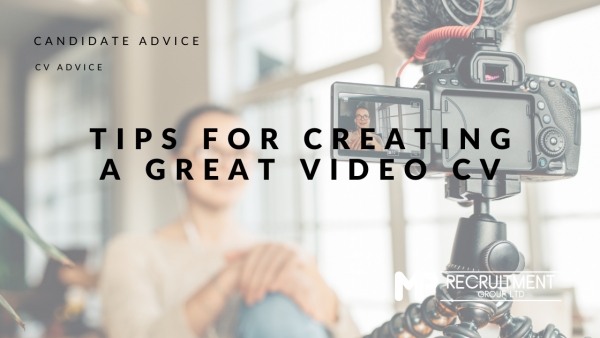Tips for creating a great video CV

People’s interest in video CVs is growing as candidates look to find more ways to stand out from the crowd in an ever-competitive market to find a new job. Yet, many people don’t know where to begin when it comes to putting a video CV together.
What is a video CV?
A video CV is a short video created by a candidate for employment and uploaded to the internet (or emailed to a hiring manager) for prospective employers to review. In the video, the candidate shares detailed information about their skills and experience. Generally, a video CV should complement a paper CV, rather than replace it altogether. The idea of a video CV is to catch the attention of a hiring manager. You can also show off your personality much better on a video CV too.
Should I use a video CV?
The idea of getting in front of a camera can be scary, but in some industries a video CV can really set you apart. Video CVs are commonly used to apply for creative and customer-facing roles in sectors such as advertising, creative arts, marketing, media, PR and sales, but you shouldn’t discount it just because you’re not working in one of these industries, as they can also be particularly useful when applying for digital, journalism, fashion or IT related roles. When deciding whether to use a video CV take into consideration the job you're applying for and the company you hope to join. Do some research into the culture of the organisation to help you decide whether it's suitable.
Preparing what to say
If you decide to give it a go, there are a number of things to consider before you start filming, first of all would be thinking of what to say. We would recommend that your video CV doesn’t drag on too long, probably between 45 to 90 seconds. Start by writing down what you want to say so you can use it as a cue when talking. You shouldn’t try to film without using a script, this can lead to forgetting some of the important points you want to get across. Learn your script beforehand so you have a good idea of what you’re going to say, then keep the script close by (but out of shot) to remind you of what to say if you get stuck.
Location and appearance
Plan the location of your video to ensure that you have a quiet, well-lit space to film in. You'll also need to consider the backdrop of your recording. It should be clear and free from clutter. If you're using a specific set or props make sure that everything that appears in your video is appropriate and professional. Appearance also matters. Plan your outfit in advance, making sure to dress as you would for an interview. This could mean a suit and tie or business casual - take your cue from the type of organisation that you're applying to.
What to include
It's so important to be genuine so don't be tempted to copy another video CV you see on YouTube. Structure the video so that it has a beginning, middle and end. Start by introducing yourself, explaining why you've created the video and why you're the right person for the job. Talk about your unique selling points and any relevant skills and experience, showing examples of your work and demonstrating your skills using slideshows, clips, or on-screen graphics if possible. At the end of your video summarise what you have told the employer and reiterate why you are right for the role. Thank them for watching the video, and don’t forget to include your contact details. Link to online platforms that could strengthen your application, such as a LinkedIn profile or website.





